Page 2032 of 2267
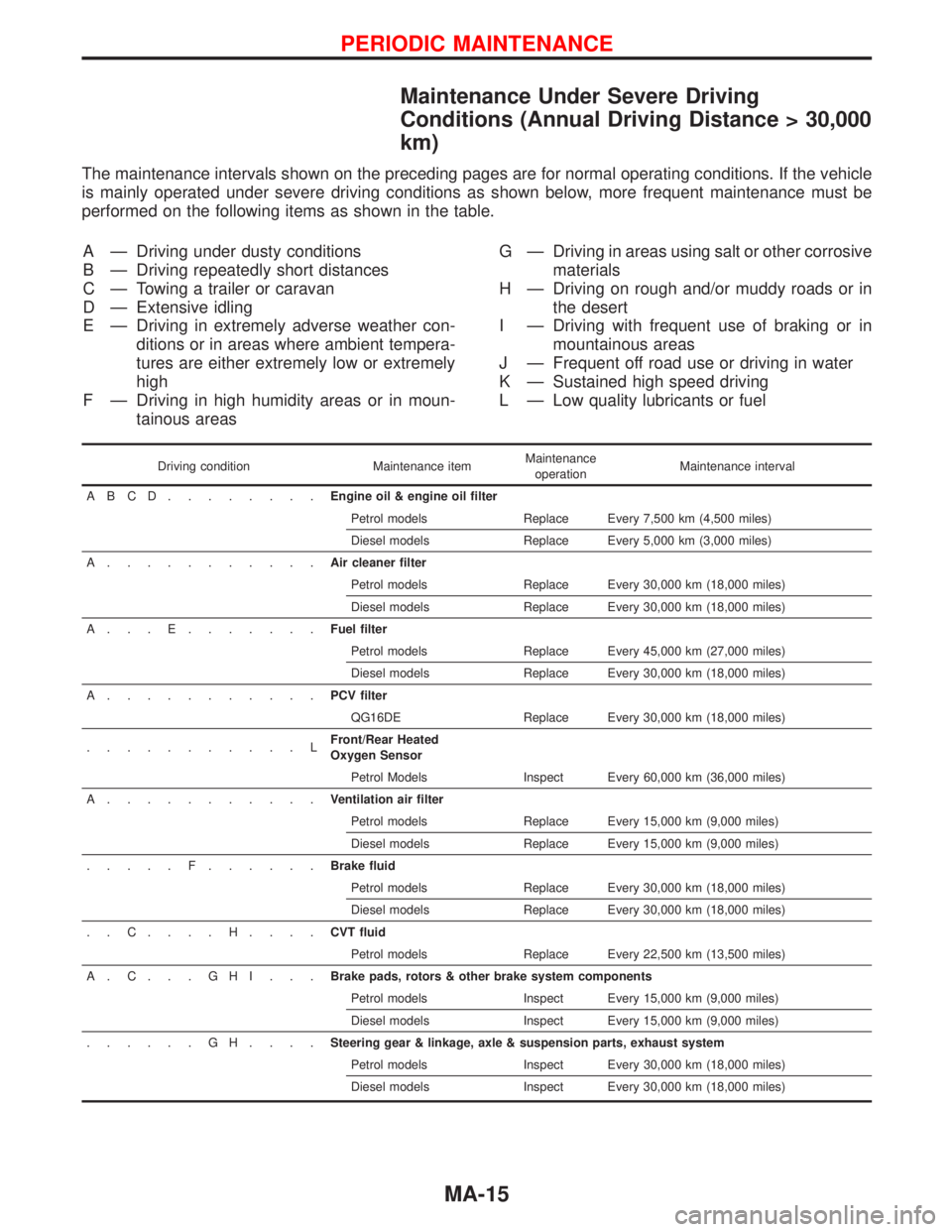
Maintenance Under Severe Driving
Conditions (Annual Driving Distance > 30,000
km)
The maintenance intervals shown on the preceding pages are for normal operating conditions. If the vehicle
is mainly operated under severe driving conditions as shown below, more frequent maintenance must be
performed on the following items as shown in the table.
A—Driving under dusty conditions
B—Driving repeatedly short distances
C—Towing a trailer or caravan
D—Extensive idling
E—Driving in extremely adverse weather con-
ditions or in areas where ambient tempera-
tures are either extremely low or extremely
high
F—Driving in high humidity areas or in moun-
tainous areasG—Driving in areas using salt or other corrosive
materials
H—Driving on rough and/or muddy roads or in
the desert
I—Driving with frequent use of braking or in
mountainous areas
J—Frequent off road use or driving in water
K—Sustained high speed driving
L—Low quality lubricants or fuel
Driving condition Maintenance itemMaintenance
operationMaintenance interval
ABCD........Engine oil & engine oil filter
Petrol models Replace Every 7,500 km (4,500 miles)
Diesel models Replace Every 5,000 km (3,000 miles)
A...........Air cleaner filter
Petrol models Replace Every 30,000 km (18,000 miles)
Diesel models Replace Every 30,000 km (18,000 miles)
A...E.......Fuel filter
Petrol models Replace Every 45,000 km (27,000 miles)
Diesel models Replace Every 30,000 km (18,000 miles)
A...........PCV filter
QG16DE Replace Every 30,000 km (18,000 miles)
...........LFront/Rear Heated
Oxygen Sensor
Petrol Models Inspect Every 60,000 km (36,000 miles)
A...........Ventilation air filter
Petrol models Replace Every 15,000 km (9,000 miles)
Diesel models Replace Every 15,000 km (9,000 miles)
.....F......Brake fluid
Petrol models Replace Every 30,000 km (18,000 miles)
Diesel models Replace Every 30,000 km (18,000 miles)
..C....H....CVT fluid
Petrol models Replace Every 22,500 km (13,500 miles)
A.C...GHI...Brake pads, rotors & other brake system components
Petrol models Inspect Every 15,000 km (9,000 miles)
Diesel models Inspect Every 15,000 km (9,000 miles)
......GH....Steering gear & linkage, axle & suspension parts, exhaust system
Petrol models Inspect Every 30,000 km (18,000 miles)
Diesel models Inspect Every 30,000 km (18,000 miles)
PERIODIC MAINTENANCE
MA-15
Page 2033 of 2267
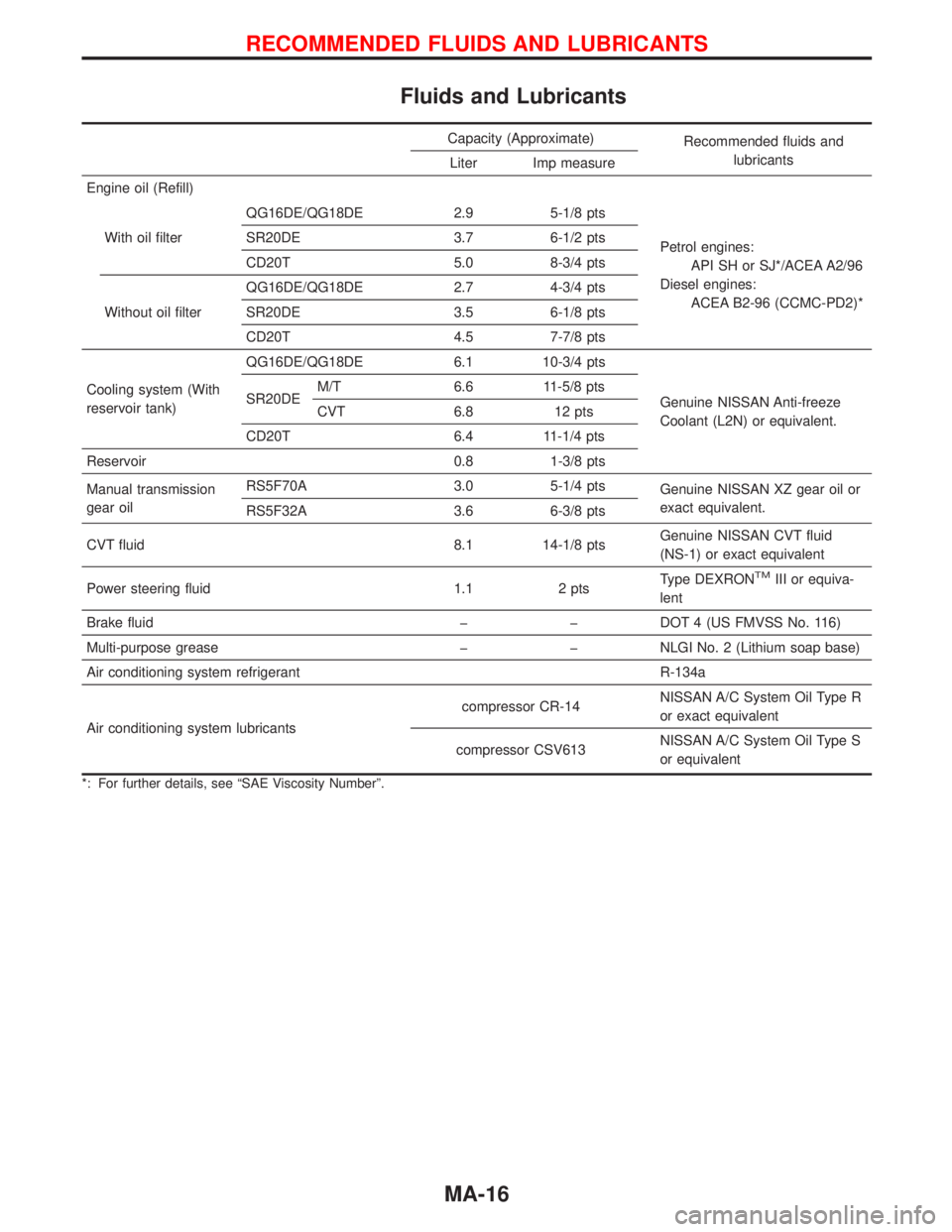
Fluids and Lubricants
Capacity (Approximate)
Recommended fluids and
lubricants
Liter Imp measure
Engine oil (Refill)
With oil filterQG16DE/QG18DE 2.9 5-1/8 pts
Petrol engines:
API SH or SJ*/ACEA A2/96
Diesel engines:
ACEA B2-96 (CCMC-PD2)* SR20DE 3.7 6-1/2 pts
CD20T 5.0 8-3/4 pts
Without oil filterQG16DE/QG18DE 2.7 4-3/4 pts
SR20DE 3.5 6-1/8 pts
CD20T 4.5 7-7/8 pts
Cooling system (With
reservoir tank)QG16DE/QG18DE 6.1 10-3/4 pts
Genuine NISSAN Anti-freeze
Coolant (L2N) or equivalent. SR20DEM/T 6.6 11-5/8 pts
CVT 6.8 12 pts
CD20T 6.4 11-1/4 pts
Reservoir 0.8 1-3/8 pts
Manual transmission
gear oilRS5F70A 3.0 5-1/4 pts
Genuine NISSAN XZ gear oil or
exact equivalent.
RS5F32A 3.6 6-3/8 pts
CVT fluid 8.1 14-1/8 ptsGenuine NISSAN CVT fluid
(NS-1) or exact equivalent
Power steering fluid 1.1 2 ptsType DEXRON
TMIII or equiva-
lent
Brake fluid��DOT 4 (US FMVSS No. 116)
Multi-purpose grease��NLGI No. 2 (Lithium soap base)
Air conditioning system refrigerant R-134a
Air conditioning system lubricantscompressor CR-14NISSAN A/C System Oil Type R
or exact equivalent
compressor CSV613NISSAN A/C System Oil Type S
or equivalent
*: For further details, see“SAE Viscosity Number”.
RECOMMENDED FLUIDS AND LUBRICANTS
MA-16
Page 2040 of 2267
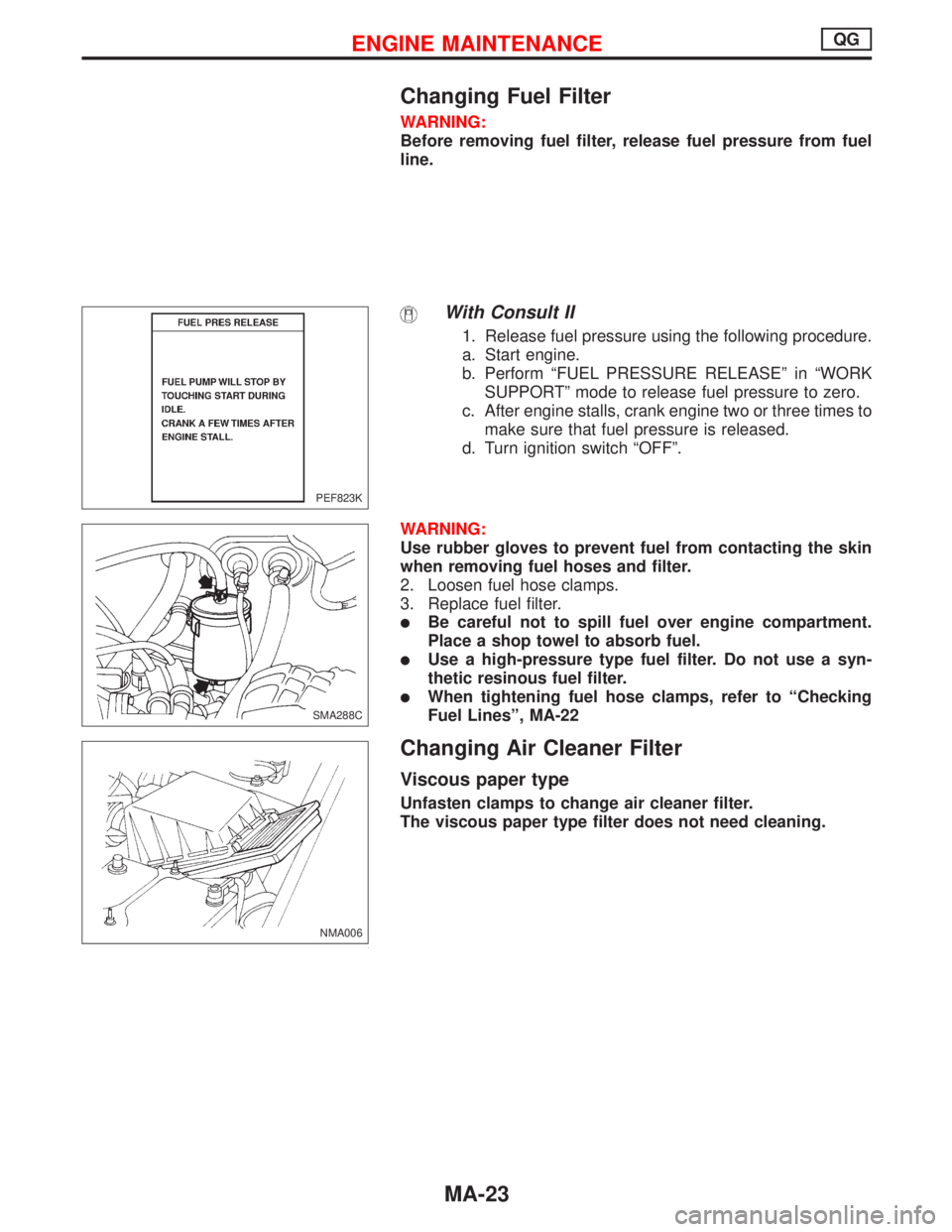
Changing Fuel Filter
WARNING:
Before removing fuel filter, release fuel pressure from fuel
line.
With Consult II
1. Release fuel pressure using the following procedure.
a. Start engine.
b. Perform“FUEL PRESSURE RELEASE”in“WORK
SUPPORT”mode to release fuel pressure to zero.
c. After engine stalls, crank engine two or three times to
make sure that fuel pressure is released.
d. Turn ignition switch“OFF”.
WARNING:
Use rubber gloves to prevent fuel from contacting the skin
when removing fuel hoses and filter.
2. Loosen fuel hose clamps.
3. Replace fuel filter.
�Be careful not to spill fuel over engine compartment.
Place a shop towel to absorb fuel.
�Use a high-pressure type fuel filter. Do not use a syn-
thetic resinous fuel filter.
�When tightening fuel hose clamps, refer to“Checking
Fuel Lines”, MA-22
Changing Air Cleaner Filter
Viscous paper type
Unfasten clamps to change air cleaner filter.
The viscous paper type filter does not need cleaning.
PEF823K
.SMA288C
.NMA006
ENGINE MAINTENANCEQG
MA-23
Page 2050 of 2267
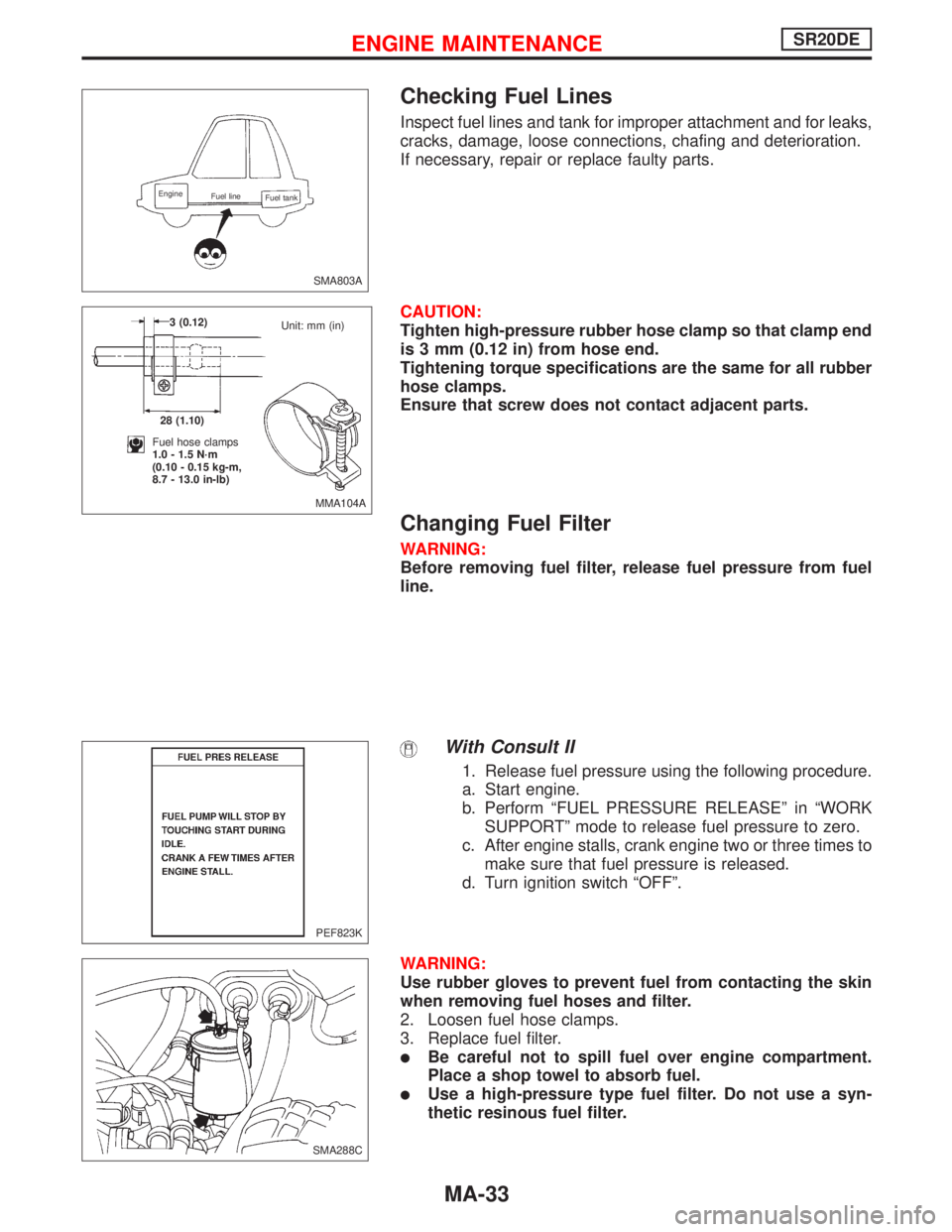
Checking Fuel Lines
Inspect fuel lines and tank for improper attachment and for leaks,
cracks, damage, loose connections, chafing and deterioration.
If necessary, repair or replace faulty parts.
CAUTION:
Tighten high-pressure rubber hose clamp so that clamp end
is 3 mm (0.12 in) from hose end.
Tightening torque specifications are the same for all rubber
hose clamps.
Ensure that screw does not contact adjacent parts.
Changing Fuel Filter
WARNING:
Before removing fuel filter, release fuel pressure from fuel
line.
With Consult II
1. Release fuel pressure using the following procedure.
a. Start engine.
b. Perform“FUEL PRESSURE RELEASE”in“WORK
SUPPORT”mode to release fuel pressure to zero.
c. After engine stalls, crank engine two or three times to
make sure that fuel pressure is released.
d. Turn ignition switch“OFF”.
WARNING:
Use rubber gloves to prevent fuel from contacting the skin
when removing fuel hoses and filter.
2. Loosen fuel hose clamps.
3. Replace fuel filter.
�Be careful not to spill fuel over engine compartment.
Place a shop towel to absorb fuel.
�Use a high-pressure type fuel filter. Do not use a syn-
thetic resinous fuel filter.
SMA803A
Engine
Fuel line
Fuel tank
MMA104A 3 (0.12)
28 (1.10)
Fuel hose clamps
1.0 - 1.5 N·m
(0.10 - 0.15 kg-m,
8.7 - 13.0 in-lb)Unit: mm (in)
PEF823K
.SMA288C
ENGINE MAINTENANCESR20DE
MA-33
Page 2051 of 2267
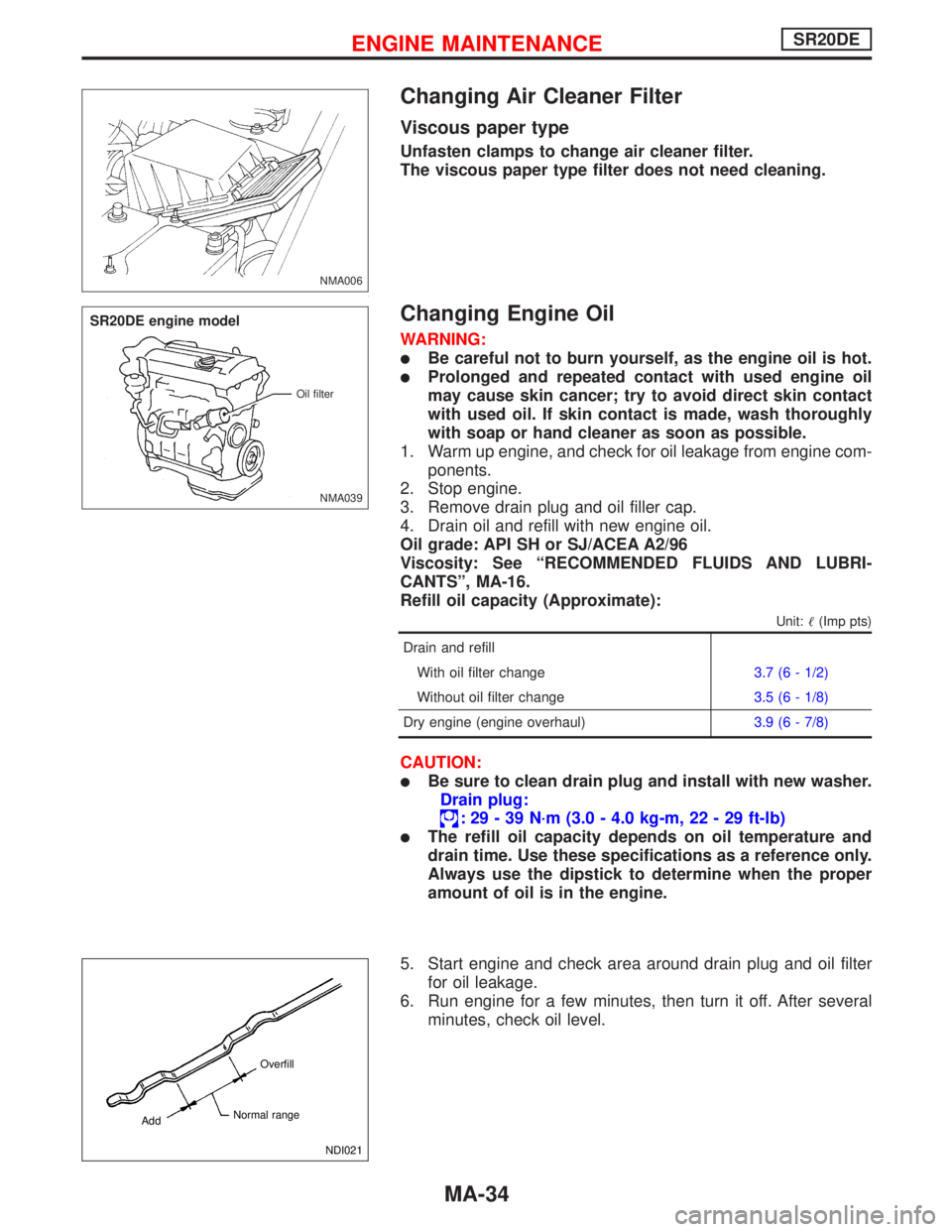
Changing Air Cleaner Filter
Viscous paper type
Unfasten clamps to change air cleaner filter.
The viscous paper type filter does not need cleaning.
Changing Engine Oil
WARNING:
�Be careful not to burn yourself, as the engine oil is hot.
�Prolonged and repeated contact with used engine oil
may cause skin cancer; try to avoid direct skin contact
with used oil. If skin contact is made, wash thoroughly
with soap or hand cleaner as soon as possible.
1. Warm up engine, and check for oil leakage from engine com-
ponents.
2. Stop engine.
3. Remove drain plug and oil filler cap.
4. Drain oil and refill with new engine oil.
Oil grade: API SH or SJ/ACEA A2/96
Viscosity: See“RECOMMENDED FLUIDS AND LUBRI-
CANTS”, MA-16.
Refill oil capacity (Approximate):
Unit:�(Imp pts)
Drain and refill
With oil filter change3.7 (6 - 1/2)
Without oil filter change3.5 (6 - 1/8)
Dry engine (engine overhaul)3.9 (6 - 7/8)
CAUTION:
�Be sure to clean drain plug and install with new washer.
Drain plug:
:29-39N·m (3.0 - 4.0 kg-m, 22 - 29 ft-lb)
�The refill oil capacity depends on oil temperature and
drain time. Use these specifications as a reference only.
Always use the dipstick to determine when the proper
amount of oil is in the engine.
5. Start engine and check area around drain plug and oil filter
for oil leakage.
6. Run engine for a few minutes, then turn it off. After several
minutes, check oil level.
NMA006
NMA039 Oil filter
SR20DE engine model
NDI021 Overfill
Normal range
Add
ENGINE MAINTENANCESR20DE
MA-34
Page 2060 of 2267
Pull the negative-pressure valve to open it. Check that it closes
completely when released.
CHECKING COOLING SYSTEM FOR LEAKS
Apply pressure to the cooling system with cap tester to check for
leakage.
Testing pressure:
157 kPa (1.57 bar, 1.6 kg/cm
2, 23 psi)
CAUTION:
Higher pressure than the specified value may cause damage
to radiator.
Checking Fuel Lines
Inspect fuel lines and tank for improper attachment and for leaks,
cracks, damage, loose connections, chafing and deterioration.
If necessary, repair or replace faulty parts.
Checking and Replacing Fuel Filter and
Draining Water
CHECKING FUEL FILTER
Check fuel filter for fuel leakage, damage and other abnormal
signs.
REPLACING FUEL FILTER
1. Disconnect fuel filter sensor connector and drain fuel.
SMA871B
SMA990A Hose adapter
EG17650301
SMA803A
Engine
Fuel line
Fuel tank
SMA794C Loosen
Drain valve
ENGINE MAINTENANCECD20T
Checking Cooling System (Cont’d)
MA-43
Page 2061 of 2267
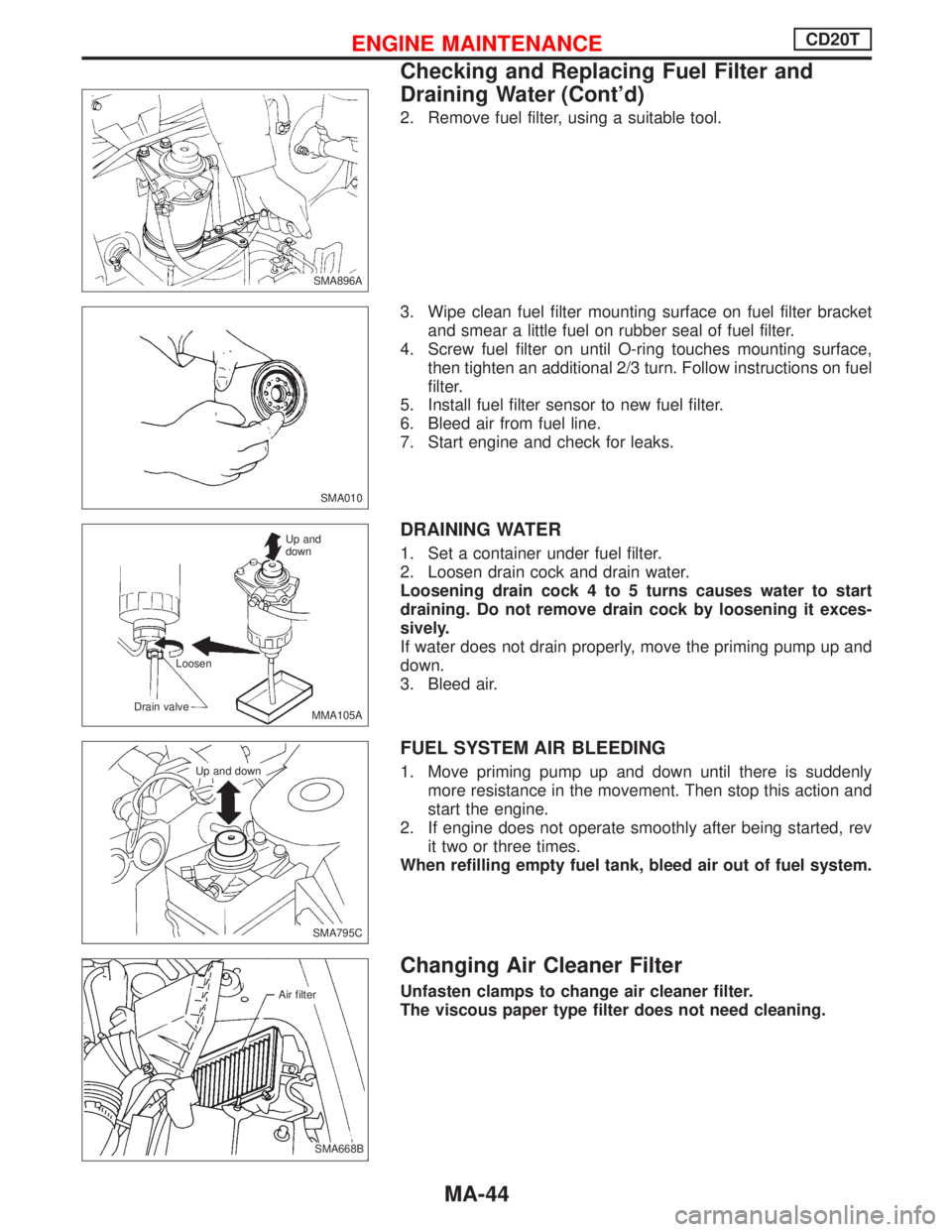
2. Remove fuel filter, using a suitable tool.
3. Wipe clean fuel filter mounting surface on fuel filter bracket
and smear a little fuel on rubber seal of fuel filter.
4. Screw fuel filter on until O-ring touches mounting surface,
then tighten an additional 2/3 turn. Follow instructions on fuel
filter.
5. Install fuel filter sensor to new fuel filter.
6. Bleed air from fuel line.
7. Start engine and check for leaks.
DRAINING WATER
1. Set a container under fuel filter.
2. Loosen drain cock and drain water.
Loosening drain cock 4 to 5 turns causes water to start
draining. Do not remove drain cock by loosening it exces-
sively.
If water does not drain properly, move the priming pump up and
down.
3. Bleed air.
FUEL SYSTEM AIR BLEEDING
1. Move priming pump up and down until there is suddenly
more resistance in the movement. Then stop this action and
start the engine.
2. If engine does not operate smoothly after being started, rev
it two or three times.
When refilling empty fuel tank, bleed air out of fuel system.
Changing Air Cleaner Filter
Unfasten clamps to change air cleaner filter.
The viscous paper type filter does not need cleaning.
SMA896A
SMA010
MMA105A Loosen
Drain valveUp and
down
SMA795C Up and down
.SMA668B Air filter
ENGINE MAINTENANCECD20T
Checking and Replacing Fuel Filter and
Draining Water (Cont’d)
MA-44
Page 2063 of 2267
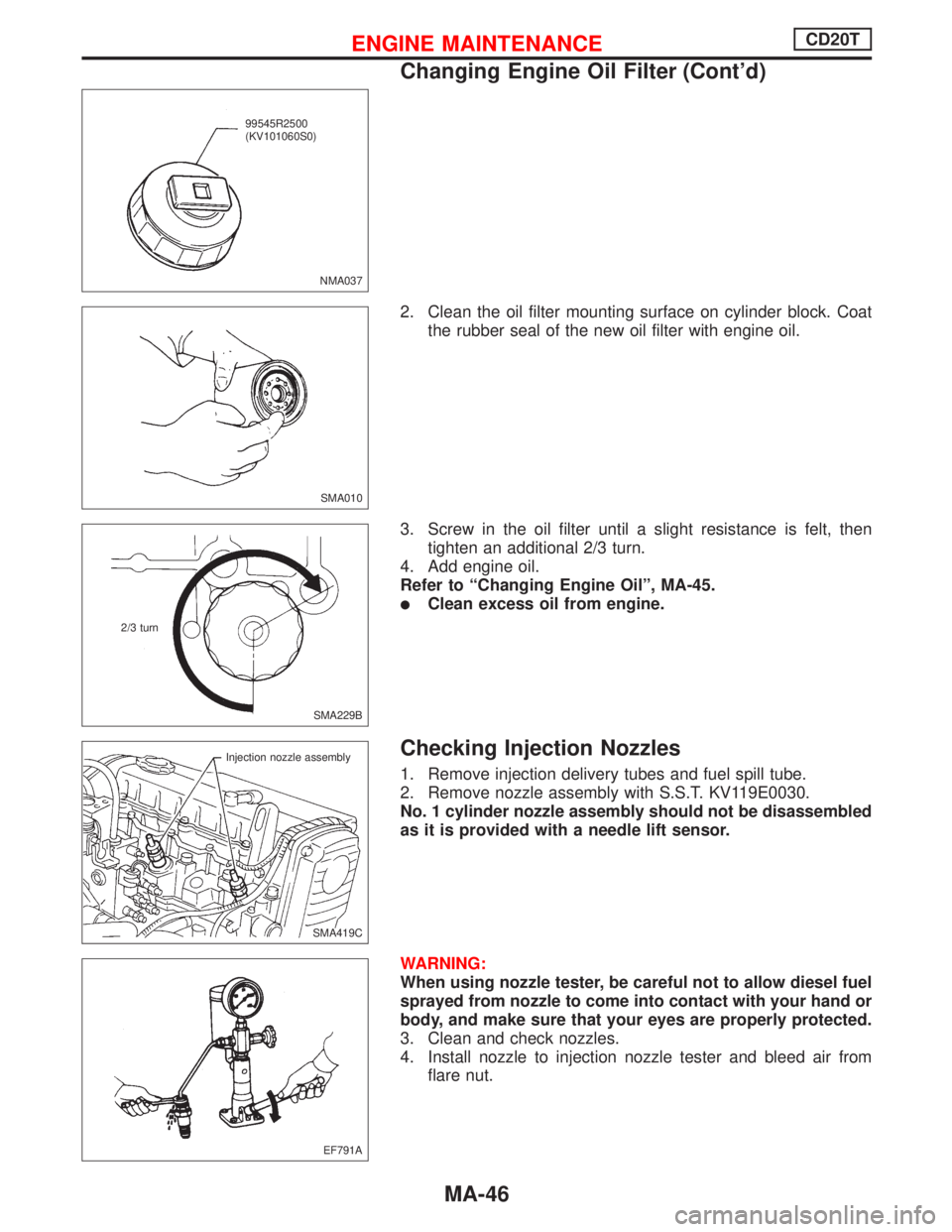
2. Clean the oil filter mounting surface on cylinder block. Coat
the rubber seal of the new oil filter with engine oil.
3. Screw in the oil filter until a slight resistance is felt, then
tighten an additional 2/3 turn.
4. Add engine oil.
Refer to“Changing Engine Oil”, MA-45.
�Clean excess oil from engine.
Checking Injection Nozzles
1. Remove injection delivery tubes and fuel spill tube.
2. Remove nozzle assembly with S.S.T. KV119E0030.
No. 1 cylinder nozzle assembly should not be disassembled
as it is provided with a needle lift sensor.
WARNING:
When using nozzle tester, be careful not to allow diesel fuel
sprayed from nozzle to come into contact with your hand or
body, and make sure that your eyes are properly protected.
3. Clean and check nozzles.
4. Install nozzle to injection nozzle tester and bleed air from
flare nut.
NMA037
.99545R2500
(KV101060S0)
SMA010
SMA229B 2/3 turn
SMA419C Injection nozzle assembly
EF791A
ENGINE MAINTENANCECD20T
Changing Engine Oil Filter (Cont’d)
MA-46